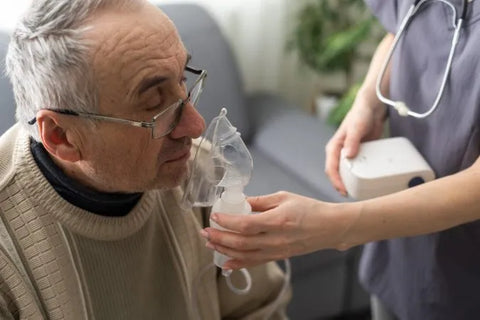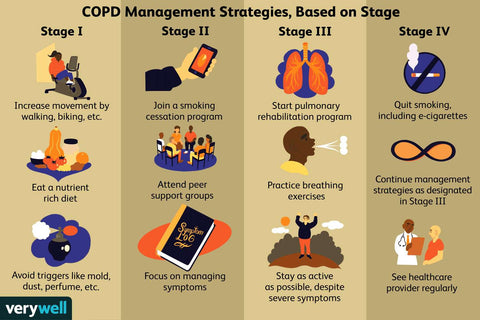
Daily Living Tips and Oxygen Therapy for COPD
Chronic obstructive pulmonary disease (COPD), which encompasses emphysema and chronic bronchitis, is a progressive lung condition that makes breathing difficult. While there's no cure for COPD, there are many ways to manage the condition and improve your quality of life. This blog post from VARON, your trusted provider of home oxygen concentrator, will equip you with practical tips for daily living categorized by the Global Initiative for Chronic Obstructive Lung Disease (GOLD) staging system and explore the benefits of oxygen therapy for COPD.
Understanding COPD and Its Impact
COPD, or Chronic Obstructive Pulmonary Disease, is a progressive lung condition characterized by damaged airways and inflamed lungs. This damage makes it difficult for air to flow freely in and out of the lungs, leading to a variety of debilitating symptoms.

The Two Main Culprits in COPD
- Emphysema: This condition involves the destruction of the air sacs (alveoli) in the lungs. These air sacs are responsible for exchanging oxygen from the inhaled air into the bloodstream and removing carbon dioxide waste. When they are damaged, the body struggles to get the oxygen it needs.
- Chronic Bronchitis: This is characterized by inflammation and thickening of the lining of the bronchial tubes, the airways that carry air to and from the lungs. This inflammation narrows the airways, further restricting airflow.
The Impact of COPD on Your Breath
Think of your lungs as tiny balloons. In healthy lungs, these balloons (air sacs) inflate easily with each breath, allowing for optimal oxygen intake. In COPD, however, these balloons are damaged or lose their elasticity, making it difficult to fully inflate them. This reduced lung capacity translates to:

- Shortness of Breath (Dyspnea): This is the hallmark symptom of COPD and can occur even with minimal exertion. It can feel like you're constantly out of breath or struggling to catch your breath.
- Wheezing: This is a whistling sound produced when air flows through narrowed airways. It's often worse during exhalation and can be quite alarming.
- Chest Tightness: This uncomfortable sensation can feel like a band is squeezing your chest, making it difficult to take a deep breath.
- Chronic Cough: A persistent cough, often productive (bringing up mucus), is another common symptom of COPD. This cough is the body's attempt to clear mucus buildup in the airways, which can further obstruct airflow.
The GOLD Classification System
The Global Initiative for Chronic Obstructive Lung Disease (GOLD) system categorizes COPD severity based on lung function and symptoms. This classification helps healthcare providers tailor treatment plans for optimal management.
Early Intervention is Key
While COPD is irreversible, early diagnosis and intervention can significantly improve quality of life and slow disease progression. Let's delve into the four stages of COPD:
Stage I: Early COPD
This initial stage may present with no noticeable symptoms or mild ones like occasional cough (productive or dry), fatigue, and shortness of breath during exertion. Early diagnosis through spirometry, a lung function test, is crucial.
Taking Action in Stage I:
Smoking cessation is the most critical step in this stage. Other preventive measures include:
- Regular exercise to improve oxygen utilization.
- Balanced diet rich in fruits and vegetables to strengthen the immune system.
- Avoiding air pollutants and triggers like dust, smoke, and strong chemicals.
Stage II: Moderate COPD
Daily activities become noticeably impacted in this stage. Symptoms like chronic cough, more severe shortness of breath, wheezing, and fatigue become more pronounced.
Diagnosis and Management of Stage II:
A spirometry test showing an FEV1 (forced expiratory volume in one second) between 50% and 79% confirms stage II. Treatment may include:
- Long-acting bronchodilator inhalers to open airways and ease breathing.
- Pulmonary rehabilitation programs involving exercise training, education, and support groups.
Stage III: Severe COPD
Symptoms worsen significantly in this stage, impacting daily activities even more. Frequent flare-ups, respiratory infections, and sleep difficulties become common.
Optimizing Care in Stage III:
Maintaining an active lifestyle with regular exercise and a healthy diet remains crucial. Pulmonary rehabilitation programs play a vital role in managing symptoms and improving quality of life.
- Treatment may include:
- Steroid inhalers to reduce lung inflammation.
- Supplemental oxygen therapy for those with resting hypoxia (low oxygen levels at rest).
Stage IV: Very Severe COPD
This advanced stage significantly restricts daily activities. Shortness of breath is often present even at rest, and oxygen levels are critically low. Other organs like the heart can be affected.
Management and Treatment in Stage IV:
- Continued focus on staying active as tolerated.
- Regular checkups and medication adjustments.
- Oxygen therapy for those requiring it.
- Surgical options like lung volume reduction surgery or lung transplant may be considered in specific cases.
Remember:
Early diagnosis and intervention are key to managing COPD effectively. If you experience any respiratory symptoms, consult your healthcare provider for prompt evaluation.
Summary of Optimizing Daily Life with COPD
Here are some daily living tips to effectively manage COPD and maintain a fulfilling life:

- Quit Smoking: Smoking is the leading cause of COPD. If you smoke, quitting is the single most important step you can take. Talk to your doctor about smoking cessation programs and resources.
- Manage Your Weight: Being overweight can worsen COPD symptoms. Maintaining a healthy weight through a balanced diet and regular exercise can significantly improve your breathing.
- Get Vaccinated: People with COPD are more susceptible to respiratory infections. Get vaccinated annually against influenza and pneumonia to minimize the risk of complications.
- Pulmonary Rehabilitation: A pulmonary rehabilitation program can teach you breathing techniques, exercises to strengthen your lungs, and strategies for managing daily activities with COPD.
- Medications: Your doctor may prescribe medications like bronchodilators and inhaled corticosteroids to manage inflammation and relax your airways, making breathing easier.
- Oxygen Therapy: In some cases, supplemental oxygen therapy becomes necessary to increase the amount of oxygen in your bloodstream, improving your breathing and overall health.
How Oxygen Concentrator Can Help
Oxygen concentrators are health care devices that electronically separate oxygen from the surrounding air and deliver it to you through a nasal cannula or mask. For people with COPD, oxygen therapy can significantly improve:
- Shortness of breath: Oxygen concentrator directly addresses the underlying oxygen deficiency, making breathing easier and reducing shortness of breath during rest and exertion.
- Exercise tolerance: With increased oxygen levels, you'll experience less fatigue and shortness of breath during physical activity, allowing you to stay active and maintain a better quality of life.
- Sleep quality: Low oxygen levels can disrupt sleep patterns. Oxygen concentrator can improve sleep quality, leading to increased energy levels and a better overall sense of well-being.
- Hospitalization risk: Studies show that oxygen concentrator can reduce the frequency and severity of COPD exacerbations, potentially lowering the risk of hospitalization.
The VARON Advantage for COPD Management
VARON offers a range of home oxygen concentrator specifically designed to meet the needs of individuals living with COPD. Our oxygen concentrators provide a reliable and continuous flow of supplemental oxygen, helping to:
- Reduce shortness of breath: By increasing the amount of oxygen in your bloodstream, VARON oxygen concentrators can significantly alleviate shortness of breath, allowing you to participate in activities you may have previously found difficult.
- Improve energy levels: With adequate oxygen, your body can function more efficiently, leading to increased stamina and energy throughout the day.
- Enhance sleep quality: Low oxygen levels can disrupt sleep. VARON oxygen concentrator can improve your sleep quality, promoting better overall well-being.
- Boost quality of life: By managing your COPD symptoms, VARON oxygen concentrator can help you regain control of your life and participate in the activities you enjoy.
Introducing the VARON Home Oxygen Concentrator Series
VARON offers several home oxygen concentrator models to suit your specific needs and preferences. Here's a closer look at some of our popular options:
| VARON 1-7L/min Home Oxygen Concentrator VH-1 | VARON 1-7L/min Home Oxygen Concentrator VH-2 | 1-7L/Min Home Oxygen Concentrator VH-3 |
- VARON 1-7L/min Home Oxygen Concentrator VH-1: This user-friendly option provides continuous flow oxygen with adjustable concentrations and features a large, easy-to-read LED display. The wireless remote control allows for effortless operation from a distance.
- VARON 1-7L/min Home Oxygen Concentrator VH-2: This versatile concentrator delivers adjustable oxygen flow rates from 1-7 liters per minute, allowing for personalized therapy. It features a user-friendly control panel, voice broadcast function, timer operation, and remote control for added convenience.
- VARON 1-7L/Min Home Oxygen Concentrator VH-3: Our most compact and lightweight home concentrator, the VH-3, is ideal for those who value portability. It offers adjustable flow rates and features like an SOS function, timer operation, and sleep mode for a comfortable therapy experience. All VARON home concentrators are designed for quiet operation, creating a peaceful environment for relaxation and sleep.
Features to Enhance Your COPD Oxygen Therapy
VARON home oxygen concentrators are equipped with features that prioritize user comfort and convenience:
- Adjustable Flow Rates: You can customize the oxygen flow rate to match your individual needs and doctor's recommendations.
- Easy-to-Use Controls: Our intuitive control panels and remote controls make operating the concentrator simple for all ages.
- Quiet Operation: Enjoy peaceful therapy sessions with our noise-reducing technology.
- Optional Nebulization: Some models come with a nebulizer attachment, allowing you to administer medication alongside oxygen therapy (consult your doctor for suitability).
- Portable Options: While primarily designed for home use, some models offer the flexibility for occasional car use with a separate inverter.
Finding the Right VARON Oxygen Concentrator for You
Choosing the right home oxygen concentrator depends on your specific needs and preferences. Consider factors like:
- Oxygen flow rate requirements.
- Desired level of portability.
- Features and functionalities that are important to you.
Looking for More Information?
We encourage you to explore our website for additional resources on COPD and oxygen therapy. If you have any questions or require assistance choosing an oxygen concentrator, please don't hesitate to contact our friendly and knowledgeable team at VARON. We're here to support you on your journey to better breathing and a healthier you.


















Laisser un commentaire